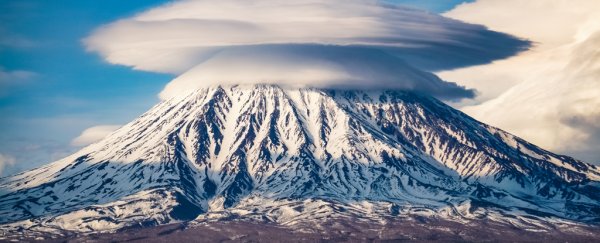Geologists expected the Westdahl Peak volcano to erupt again by 2010, yet it sits still intact and restless – pointing to flaws in our predictive models.
Trying to accurately warn when volcanoes will go boom is a crucial but tricky business to protect surrounding people and reduce aviation risks. So many factors must be considered, and this lack of explosion has highlighted one that has mostly been overlooked.
"Volcanic forecasting involves a lot of variables, including the depth and size of a volcano's magma chamber, the rate at which magma fills that chamber, and the strength of the rocks that contain the chamber, to name a few," says geologist Lilian Lucas.
Located in western Alaska, along the Aleutian Islands chain, the Westdahl Peak Shield volcano last blew in a series of eruptions between 1991 and 1992. The volcano has continued to swell since, threatening more action to come – with an active magma chamber bubbling away around 7.2 kilometers (4.47 miles) beneath its surface.
Its most obvious feature that differs from many volcanoes elsewhere in the world is that a 1-kilometer-thick ice cap also blankets the Westdahl Peak volcano.
"Our numerical experiments indicate that the presence of an ice cap (1–3 kilometer thick) increases the average repose interval for a magma system," Lucas and colleagues write in their paper.
Using computer simulations University of Illinois researchers found a linear relationship between ice-cap thickness and the volume changes needed within the volcano to overcome the strength of the encasing rock and explode. It is also dependent on the production rate of magma at a volcano – the magma flux.
Taking into account the magma chamber size, geometry, and magma flux, the team calculated that for the Westdahl system, the pressure from the ice cap adds around 7 years of dormancy, compared to models without the ice.
"These increases in time may seem insignificant on a geologic scale, but it is significant on the human time scale," says geologist Patricia Gregg. "Going forward, it will be important to account for glacial ice cover in future forecasting efforts."
However, while the ice cap may account for some of Westdahl's unexpected stability, there's still more to the story, the researchers caution. Their study assumed constant flux, which does not capture the dynamics of other systems such as those that have been long dormant.
"We do not know how close to failure the system is currently, and recent geodetic data have not yet been investigated to update our estimates of the system's flux rate," they write.
"If the flux into Westdahl's magma reservoir has slowed in recent years while the system remains close to failure, seasonality may ultimately play a larger role than would be expected."
A volcano's shape and depth are still the biggest factors in delays before an eruption; however, when the system approaches a certain threshold and flux is low, the weight of ice caps comes more into play, the team explains, to the point where even seasonal variation in the ice above may be enough to trigger it to blow.
Therefore, "it will be important to consider how climate change and glacial ice melt might impact Westdahl Peak and other high-latitude volcanoes in the future," says geologist Yan Zhan.
"Accounting for overlying pressure from polar ice caps is another critical, yet poorly understood, variable," Lucas concludes.
This research was published in Frontiers in Earth Science.
